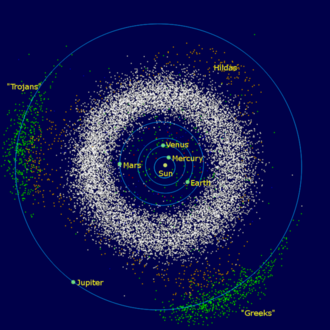Jupiter trojan
Jupiter trojans, also known as Trojan asteroids, are a large group of asteroids that share the planet Jupiter's orbit around the Sun. They are divided into two groups: those that orbit ahead of Jupiter in its path, known as the "Greek camp" or L4 group, and those that follow behind, referred to as the "Trojan camp" or L5 group. These terms derive from the Trojan War of Greek mythology, with the L4 and L5 groups named after the Greek and Trojan sides, respectively.
Discovery and Exploration
The first Jupiter trojan discovered was 588 Achilles, identified in 1906 by German astronomer Max Wolf. The discovery of Achilles provided the first evidence of minor planets sharing an orbit with a larger planet. Since then, thousands of Jupiter trojans have been identified, making them the most populous group of minor planets in the Solar System after the main asteroid belt.
Characteristics
Jupiter trojans are thought to be remnants from the early Solar System, trapped in Jupiter's orbit by gravitational forces. They are primarily composed of rock and ice, and their sizes range from a few kilometers to several hundred kilometers in diameter. The largest known Jupiter trojan, 624 Hektor, has an elongated shape and measures approximately 250 km in length.
The distribution of Jupiter trojans is not uniform; the L4 group is slightly larger than the L5 group, but the reasons behind this asymmetry remain a subject of research. Studies suggest that the Jupiter trojans have similar colors and compositions, indicating a common origin.
Dynamics and Stability
The stability of Jupiter trojans' orbits is a result of the Lagrangian points—specific areas in a two-body system where the gravitational forces and the orbital motion balance out. The L4 and L5 points, where the Jupiter trojans reside, are stable and can hold objects for billions of years. Theoretical models and computer simulations have shown that the trojans' orbits are stable over the lifetime of the Solar System, although they can be perturbed by major planetary migrations or collisions.
Scientific Importance
Jupiter trojans are of great interest to scientists because they offer insights into the early Solar System's history and the processes of planetary formation. Studying these asteroids can help researchers understand more about the distribution of materials in the early Solar System and the dynamics of planet formation. Missions like Lucy, launched by NASA in 2021, aim to explore several Jupiter trojans, providing valuable data on their physical properties, compositions, and the environments in which they formed.
Future Exploration
The exploration of Jupiter trojans is expected to expand significantly in the coming years, with missions like Lucy paving the way for future research. These efforts will not only enhance our understanding of Jupiter trojans but also contribute to our knowledge of the Solar System's formation and evolution.
Transform your life with W8MD's budget GLP-1 injections from $125.
W8MD offers a medical weight loss program to lose weight in Philadelphia. Our physician-supervised medical weight loss provides:
- Most insurances accepted or discounted self-pay rates. We will obtain insurance prior authorizations if needed.
- Generic GLP1 weight loss injections from $125 for the starting dose.
- Also offer prescription weight loss medications including Phentermine, Qsymia, Diethylpropion, Contrave etc.
NYC weight loss doctor appointments
Start your NYC weight loss journey today at our NYC medical weight loss and Philadelphia medical weight loss clinics.
- Call 718-946-5500 to lose weight in NYC or for medical weight loss in Philadelphia 215-676-2334.
- Tags:NYC medical weight loss, Philadelphia lose weight Zepbound NYC, Budget GLP1 weight loss injections, Wegovy Philadelphia, Wegovy NYC, Philadelphia medical weight loss, Brookly weight loss and Wegovy NYC
|
WikiMD's Wellness Encyclopedia |
| Let Food Be Thy Medicine Medicine Thy Food - Hippocrates |
Medical Disclaimer: WikiMD is not a substitute for professional medical advice. The information on WikiMD is provided as an information resource only, may be incorrect, outdated or misleading, and is not to be used or relied on for any diagnostic or treatment purposes. Please consult your health care provider before making any healthcare decisions or for guidance about a specific medical condition. WikiMD expressly disclaims responsibility, and shall have no liability, for any damages, loss, injury, or liability whatsoever suffered as a result of your reliance on the information contained in this site. By visiting this site you agree to the foregoing terms and conditions, which may from time to time be changed or supplemented by WikiMD. If you do not agree to the foregoing terms and conditions, you should not enter or use this site. See full disclaimer.
Credits:Most images are courtesy of Wikimedia commons, and templates, categories Wikipedia, licensed under CC BY SA or similar.
Contributors: Prab R. Tumpati, MD





